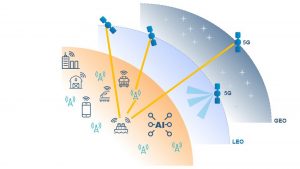5G and 6G are targeting a unified telecommunication ecosystem, which necessitates the extension of traditional terrestrial infrastructure to the sky by integrating non-terrestrial networks into a unique technology picture.
The unprecedented quality of service figures demanded initially by 5G and later strengthened by the ambitious targets coming from 6G have radically transformed the telecommunication ecosystem.
More specifically, the usual approach building on the ‘one-fits-all’ design paradigm cannot meet the ambitious and diverse service requirements demanded by many verticals, whereby the terrestrial infrastructure alone cannot meet these goals. On the contrary, the convergence with non-terrestrial network counterparts, i.e. air- and space-borne systems such as satellites, is regarded today as a natural extension of usual network systems to fulfil all the expectations from industry and society. This trend is further confirmed by the standardisation approach taken in 3GPP towards the definition of 6G, where the co-existence of terrestrial and non-terrestrial networks is the key novel aspect compared to previous cellular generations. This new trend is determined by the need to provide connectivity with unprecedented quality of service figures in several sectors, which have historically suffered from limited or even total lack of terrestrial infrastructure, as in the case of remote areas or, even more importantly, in applications such as maritime, aeronautical, or disaster management sectors.
In this respect, the 5G-STARDUST project is expected to play an important role towards the materialisation of such a planned convergence between terrestrial and non-terrestrial networks in the short term, i.e. focusing on the realisation of the so-called 5G-advanced standardisation wave from 3GPP. In more detail, 5G-STARDUST is a European project funded by the Smart Network Service (SNS) Joint-Undertaking (JU) initiative as part of the Horizon Europe programme. The project has been selected for funding from the first SNS call year 2022 and contractually started on 01 January 2023. The project will then run for three years until 31 December 2025, with the ultimate goal of demonstrating the achieved convergence between terrestrial and non-terrestrial networks by means of advanced laboratory testbeds.
5G-STARDUST’s goals
5G-STARDUST means ‘Satellite and Terrestrial Access for Distributed, Ubiquitous, and Smart Telecommunications’, and its main mission is to design, develop and demonstrate a deeper integration of TN and NTN. As such, the main planned outcome is to deliver a fully integrated 5G-NTN autonomous system with novel self-adapting end-to-end connectivity models for enabling ubiquitous radio access. More specifically, a few objectives have been defined in terms of consecutive milestones to fulfil the mission statement, as shortly outlined below:
- To define an integrated terrestrial-satellite network building on 5G-compliant regenerative satellite payloads, enabling cost-effective connectivity in underserved areas;
- To ensure a more efficient user connectivity concept by providing geographic coverage according to user-centric approaches (i.e. cell-free strategies);
- To define a self-organised end-to-end network architecture able to adapt to diverse verticals’ requirements and to time-varying network operations (e.g., data traffic loads and topology changes);
- To provide end-to-end network flexibility by means of data-driven AI-based multi-connectivity and resource allocation strategies; and
- To guarantee cost reduction and capability to scale up the integration of satellites with terrestrial infrastructures to manage the deployment and operation of massive capacity networks efficiently.
To reach these ambitious targets, 5G-STARDUST counts on a very diversified and competitive consortium bringing together expertise from academia, research institutions, satellite and terrestrial operators, and vendors and manufacturers from both satellite and terrestrial networks.

Examples of use
The overall objectives are considered a target to show the main building blocks necessary to achieve such a converged network system. More importantly, the final objective will be to demonstrate the suitability of the designed architecture for a number of uses, which have been conveniently subdivided into:
Dual connectivity
- Airway GEO and NGSO complement terrestrial coverage when aeroplanes leave the airport. 5G broadband services for passengers with terrestrial and satellite, providing a homogeneous and transparent experience for users.
- Direct Access/LEO (IAB), helping to fast deploy networks to accelerate terrestrial 5G rural deployments or temporal gap filler. FWA from LEO/GEO with dual connectivity and common O&M with terrestrial and satellite, providing a homogeneous and transparent experience for users and a common management for the MNOs
Architecture and service distribution
- V2N communications to enhance three different services like over-the-air software updates, HD map updates, and NG eCall service to provide rapid assistance in serious accidents; using TN and LEO satellites to extend V2N coverage for underserved areas.
- PPDR communication in case TN infrastructure is damaged during a disaster event. NTN will provide temporary coverage for first responders. Also, extended coverage for first responder agencies is considered in case of uncovered areas. Direct and backhauled access to LEO satellites.
- Distributed 5G Systems for private networks. LEO onboarded with UPF, ensuring shorter
global data paths, data retention, and potentially ultra-secure and ultra-reliablesignalling centralised in the satellite environment.
To address all the planned scenarios, the project consortium is in the phase of defining a holistic architecture that adapts to the different scenario requirements by resorting to end-to-end network programmability concepts and an overall network self-organised paradigm. As such, the ultimate goal is to achieve a fully flexible and modular architecture whose main components will be configured and interconnected according to the main peculiarities of the targeted scenarios. More specifically, the overall layout of the architecture will be strictly aligned with the finalised specification of 3GPP Rel. 17 and the current ones under completion within Rel. 18. Further to this, the plan is to influence the planning of Rel. 19, with a special focus on regenerative satellites to exploit further networking options directly from the sky, i.e. relying on gNB placed onboard satellite system (either entirely or through CU/DU functional splitting) or by means of integrated-access backhaul (IAB) concepts.
In conclusion, 5G-STARDUST is a very ambitious project aimed at demonstrating the potential of converging regenerative satellites with terrestrial infrastructures in a number of prospective scenarios. Last but not least, the project contributes to the standardisation of 3GPP to mature the current specifications part of the overall 5G-Advanced wave towards the conception of 6G network system elements.
 5G-STARDUST project has received funding from the Smart Networks and Services Joint Undertaking (SNS JU) under the European Union’s Horizon Europe research and innovation programme under Grant Agreement No 101096573.
5G-STARDUST project has received funding from the Smart Networks and Services Joint Undertaking (SNS JU) under the European Union’s Horizon Europe research and innovation programme under Grant Agreement No 101096573.
Please note, this article will also appear in the sixteenth edition of our quarterly publication.









